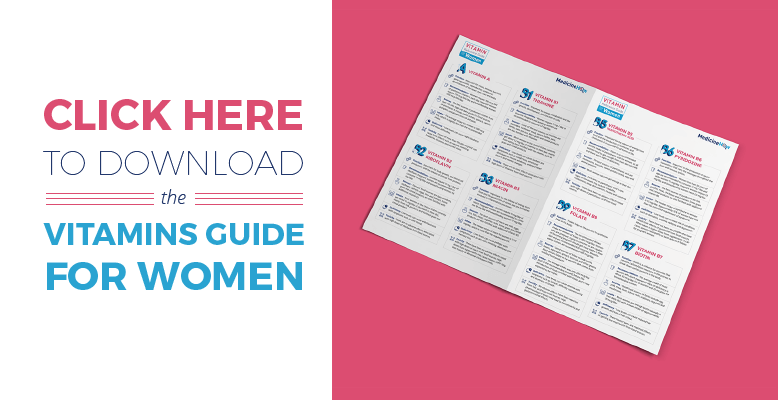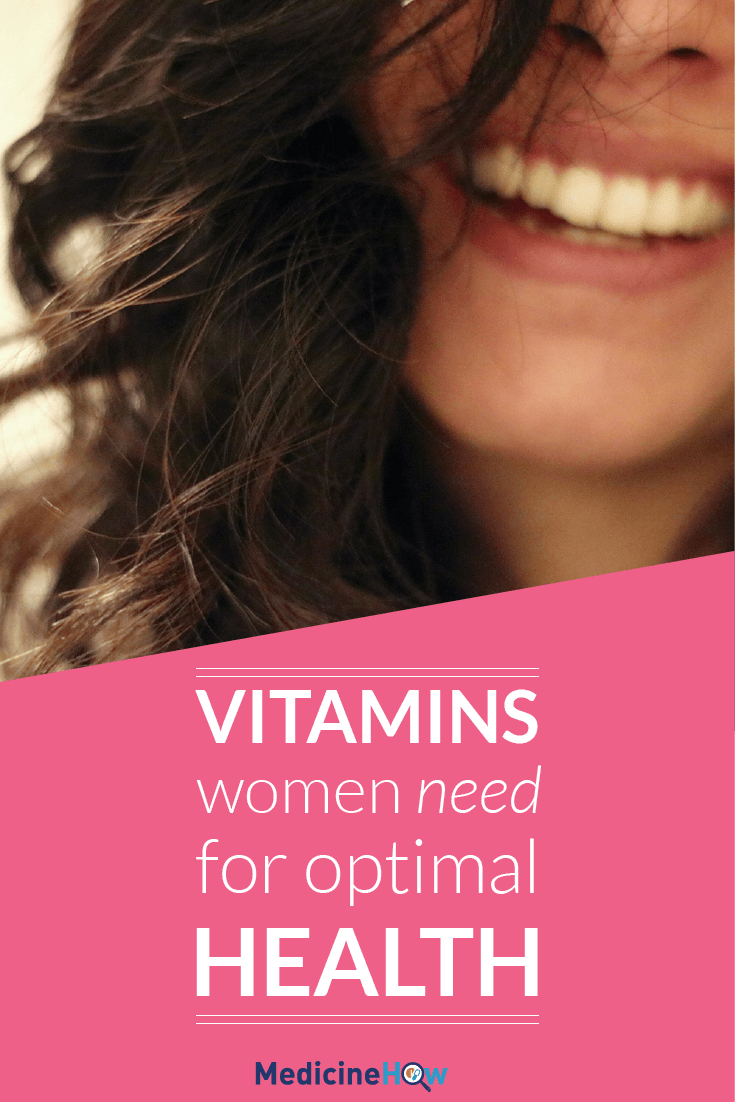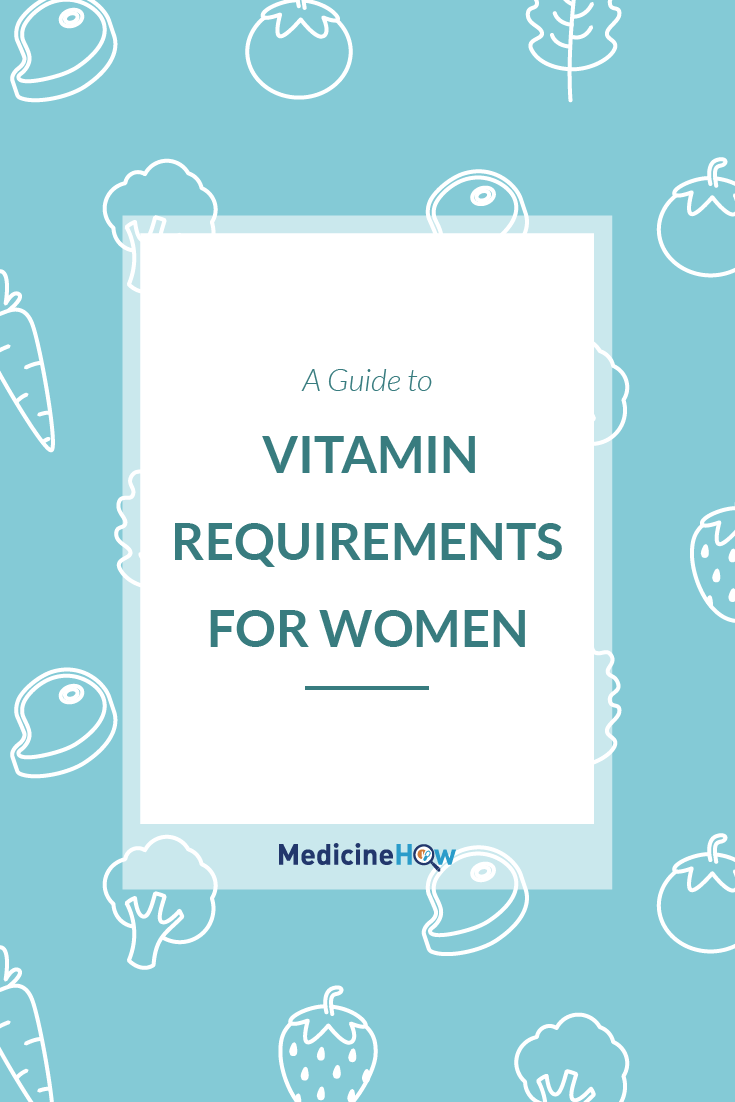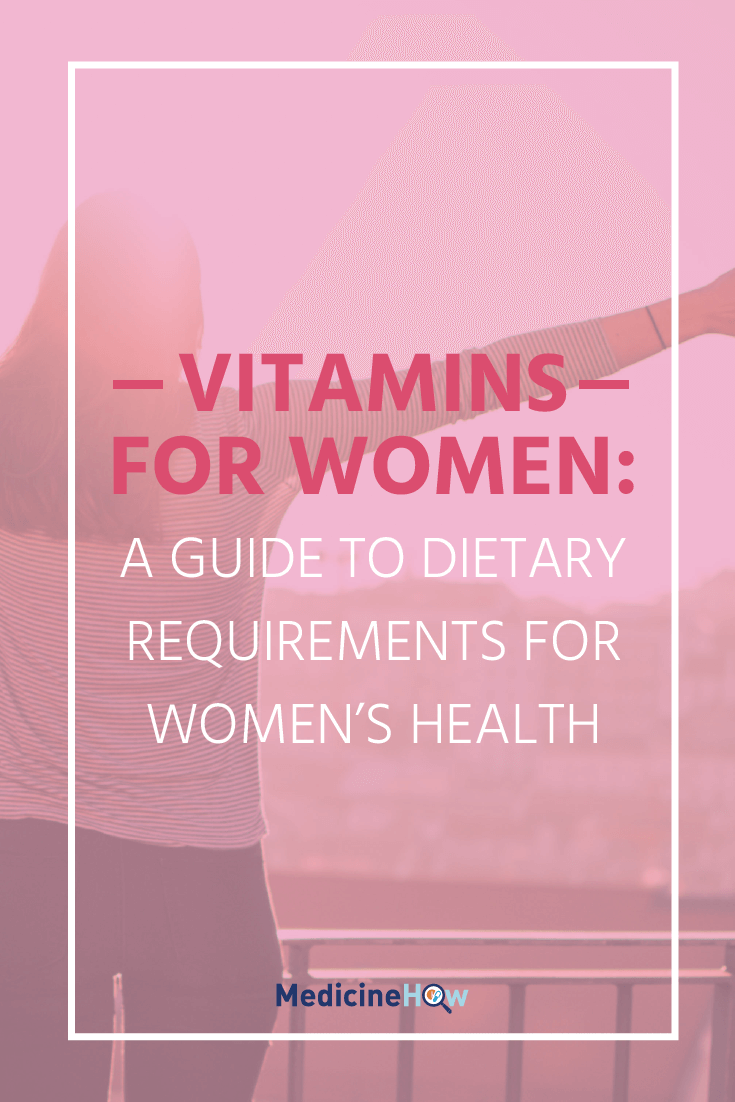
Food and nutrition is a complex and confusing field to get your head around. If you are a woman who is trying to nourish your body by eating the right things, it can be difficult to know where to find reputable information about what to eat. I hope that this guide about vitamins for women to promote health and vitality will be a good starting point for you.
I hope that this guide about vitamins for women to promote health and vitality will be a good starting point for you.
For anyone not entirely sure out there, a vitamin is any substance that our body requires in small amounts to function normally, and that we can’t produce within our body so we need to get our dose of vitamins from the things we eat.
I’m a big believer that in the vast majority of cases, we should be able to get the vitamins that we need from the food we eat. There shouldn’t be any need for vitamins or supplements if you eat right and live well.
So keep in mind as you’re reading this guide that it is intended to help you make healthy choices about the food you eat. When you have a good understanding of what vitamins do, why you need them and how to get them into your diet, it is much easier for you to follow through and actually begin to make some changes.
First, we’re going to do an overview of each of the important vitamins, and then we’ll put it all together with a recap of the requirements of vitamins for women. Simply click on the links below if you want to jump to a specific section!

- Vitamin A
- Vitamin B1 – Thiamin
- Vitamin B2 – Riboflavin
- Vitamin B3 – Niacin
- Vitamin B5 – Pantothenic Acid
- Vitamin B6 – Pyridoxine
- Vitamin B7 – Biotin
- Vitamin B9 – Folate
- Vitamin B12 – Cobalamin
- Vitamin C
- Vitamin D
- Vitamin E
- Vitamin K
- Guide to Vitamins for Women
Vitamin A
 Vitamin A, also known as retinol or retinoic acid, is a group of compounds that play an important role in the body to maintain vision, reproduction, cellular communication and immune function. It is also essential for gene expression and embryonic growth, so more vitamin A is need for women who are pregnant or breastfeeding.
Vitamin A, also known as retinol or retinoic acid, is a group of compounds that play an important role in the body to maintain vision, reproduction, cellular communication and immune function. It is also essential for gene expression and embryonic growth, so more vitamin A is need for women who are pregnant or breastfeeding.
There are two types of vitamin A: preformed vitamin A that comes from animal products and provitamin A from plant-based foods. It’s possible for women to get all of the vitamin A needed from plant foods, but the vitamin A found in animal products is in the form ready for the body to use.
If you are mostly getting your vitamin A as provitamin A from plant foods, you will need more provitamin A to reach the equivalent amount of preformed vitamin A. For example, 12 mcg of beta-carotene is equal to 1 mcg of provitamin A, so you would need twelve times as much of the vitamin. For dietary requirements, nutritionists use Retinol Equivalent Activity (RAE) to account for the difference.
What does vitamin A do? Important for vision, immune function, gene expression, reproduction, embryonic development of the heart, eyes, ears and limbs.
How much vitamin A women need? On average, women require 700 mcg RAE of preformed vitamin A each day. Pregnant women require 770 mcg RAE/day and breastfeeding women 1300 mcg RAE/day.
How much is too much? Doses of more than 150,000 mcg RAE can cause toxic effects such as nausea, vomiting, headache, dizziness and blurred vision. Chronic toxicity with consistent doses of 30,000 mcg RAE daily for months or years can also cause effects.
Where to get vitamin A? The best sources of preformed vitamin A are liver, fish oils, eggs and dairy products. Good sources of provitamin A include sweet potato, spinach, carrots, pumpkin, cantaloupe, broccoli and peas.
Do women usually get enough? The average intake for women in the United States is approximately 580 mcg RAE. This is slightly less than the recommended dietary intake (RDI), but is still more than the estimated average requirement (EAR). So we’re not doing too badly, but could be doing better.
Vitamin B1 – Thiamine
 Vitamin B1, also known as thiamine, is a water-soluble vitamin that is important for energy metabolism and the growth, development, and function of cells.
Vitamin B1, also known as thiamine, is a water-soluble vitamin that is important for energy metabolism and the growth, development, and function of cells.
Continuing to eat a diet deficient in thiamine eventually leads to a condition known as beriberi. People with vitamin B1 deficiency may experience symptoms such as weight loss, emotional disturbances muscle weakness, enlarged heart muscle and mental changes (e.g. decreased short-term memory, confusion and irritability).
What does thiamine do? Important for energy metabolism and the growth, development, and function of cells.
How much thiamine women need? On average, women require 1.1 mg / day of thiamine. Both pregnancy and lactating women need more and are recommended to consume 1.4 mg/day to meet the increased energy requirements.
How much is too much? There’s very little data available about the toxic effects of thiamine. Several supplements are available without a prescription with as dose of 50 mg of thiamine, although we don’t know how safe thiamine is at these levels.
Where to get thiamine? Some of the best sources of thiamine are asparagus, sunflower seeds, beans, barley, peas, lentils, oats and rice. Many grain and cereal products are also fortified with added thiamine content to help to increase dietary intake.
Do women usually get enough? Most women in the United States currently get about 1.2 mg/day of thiamine in their diet, mainly from eating food fortified with the vitamin, such as grain and cereal products. This mean that the majority get enough, but up to 1 in 10 of breastfeeding women consume less thiamine in their diet than recommended.
Vitamin B2 – Riboflavin
 Vitamin B2, also known as riboflavin, is a coenzyme needed for many redox reactions in the body to take place. It plays an important role in body growth, red blood cell production, and the release of energy from proteins.
Vitamin B2, also known as riboflavin, is a coenzyme needed for many redox reactions in the body to take place. It plays an important role in body growth, red blood cell production, and the release of energy from proteins.
When people do not consume enough riboflavin and become deficient in vitamin B2, they can develop a condition known as ariboflavinosis, with symptoms such as a sore throat. Most people with deficient in riboflavin are also lacking other vitamins and are more likely to be affected by cardiovascular disease, diabetes and cancer.
What does riboflavin do? Important for body growth, red blood cell production, and the release of energy from proteins.
How much riboflavin women need? On average, women require 1.1 mg / day of riboflavin. Both pregnancy and lactating women need more: pregnant women are recommended to consume 1.4 mg/day and breastfeeding women 1.6 mg/day to meet the increased energy requirements.
How much is too much? There have been no adverse effects noted with high doses of riboflavin from food sources, and when too much is consumed, it is mostly excreted in the faeces.
Where to get riboflavin? Some of the best sources of riboflavin are dairy products, soy beans, spinach, eggs, liver and kidneys. Some grain and cereal products are also fortified with additional vitamin B2.
Do women usually get enough? Most women in the United States currently get about 1.5 mg/day of riboflavin in their diet, mainly from milk products and fortified grain and cereal products. This means that most consume enough of the vitamin, although some pregnant or breastfeeding women may be getting less than they need.
Vitamin B3 – Niacin
 Vitamin B3, also known as niacin, is an important coenzyme for many redox reactions in the body. It helps to convert food to energy in the body, as well producing hormones in the body that regulate sex, stress and inflammation.
Vitamin B3, also known as niacin, is an important coenzyme for many redox reactions in the body. It helps to convert food to energy in the body, as well producing hormones in the body that regulate sex, stress and inflammation.
Severe deficiency of niacin can lead to pellagra, which is a condition that involves skin rash and irritation, vomiting, diarrhoea and loss of memory. This was a common condition about a century ago but is much less common now because many foods are fortified with vitamin B3.
What does niacin do? Important for the release of energy from food and the production of stress and sex hormones that are involved in the process of inflammation.
How much niacin women need? On average, women require 14 mg / day of niacin. Pregnant women are recommended to consume 18 mg/day and breastfeeding women 17 mg/day to meet the increased energy requirements for their body.
How much is too much? There have been no adverse effects noted with high doses of niacin from food sources. When taken in high doses from supplements, it may contribute to abnormal cholesterol levels or cause nausea, vomiting or liver toxicity.
Where to get niacin? Some of the best sources of niacin are milk, eggs, rice, fish, meats, legumes, nuts. Some grain and cereal products are also fortified with additional vitamin B3.
Do women usually get enough? The median intake of niacin for women in the United States is 17-20mg/day, which is more than the required amount. The intake mainly comes from the consumption of meat, fish and fortified grain and cereal products.
Vitamin B5 – Pantothenic Acid
 Vitamin B5, also known as pantothenic acid, vital for all forms of life, as it is involved in the production of co-enzyme A, which is important for many enzymatic processes. It is needed to convert fat, protein and carbohydrate in food to energy, as well as to produce hormones and cholesterol.
Vitamin B5, also known as pantothenic acid, vital for all forms of life, as it is involved in the production of co-enzyme A, which is important for many enzymatic processes. It is needed to convert fat, protein and carbohydrate in food to energy, as well as to produce hormones and cholesterol.
It is rare for women to be deficient in pantothenic acid. In fact, only people that have purposely been fed a diet low in vitamin B5 for scientific studies are known to have experienced symptoms, which included irritability, restlessness, sleep disturbances, nausea and vomiting.
What does pantothenic acid do? Important for the release of energy from food and the production of hormones and cholesterol. It is essential for all forms of life.
How much pantothenic acid women need? There is no recommended dietary intake of pantothenic acid for women, as all women tend to get enough from their diet naturally and there aren’t signs of deficiency. The average intake for women is 5 mg/day (6mg for pregnant women and 7 mg for breastfeeding women).
How much is too much? There have been no adverse effects noted with high doses of pantothenic acid from food sources.
Where to get pantothenic acid? Some of the best sources of pantothenic acid are mushrooms, avocado, sweet potato, lentils, eggs and animal proteins.
Do women usually get enough? Yes. Deficiency in pantothenic acid is rare, so just keep on eating what you are eating!
Vitamin B6 – Pyridoxine
 Vitamin B6, also known as pyridoxine, plays an important role in the body to produce neurotransmitters that carry messages throughout the body. It is involved in the development and function of the brain and can affect the mood and body clock rhythms. With vitamin B9 and B12, it also controls the levels of homocysteine in the blood, which is an amino acid that may be linked to heart disease.
Vitamin B6, also known as pyridoxine, plays an important role in the body to produce neurotransmitters that carry messages throughout the body. It is involved in the development and function of the brain and can affect the mood and body clock rhythms. With vitamin B9 and B12, it also controls the levels of homocysteine in the blood, which is an amino acid that may be linked to heart disease.
Women deficient in pyridoxine are more likely to be affected by conditions such as seborrheic dermatitis, microcytic anaemia, epilepsy, depression and other psychological effects. This is mainly due to the changes in neurotransmitters, as they can’t be produced properly when there is less vitamin B6 available.
What does pyridoxine do? Important in the production of neurotransmitters that carry the messages throughout the brain and nervous system.
How much pyridoxine women need? Women less than 50 years of age are recommended to consume 1.3 mg of pyridoxine per day. Older women require slightly more and are recommended to consume 1.5 mg/day. Pyridoxine is important during pregnancy and breastfeed, so pregnant women require 1.9 mg/day and breastfeeding women need 2.0 mg/day.
How much is too much? There have not been any people who have noted toxic effects of pyridoxine from food sources. When taken in higher doses from supplements, it can cause sensory neuropathy or birth defects in babies whose mother took high doses during pregnancy.
Where to get pyridoxine? Some of the best sources of pyridoxine are fish, poultry, meat, chickpeas and potatoes. Some grain and cereal products are also fortified with additional vitamin B6.
Do women usually get enough? The median intake of pyridoxine in women is 1.5 mg/day. This is enough for most women, although pregnant and breastfeeding women have higher requirements. Approximately 15% of women have less than the estimated requirement of pyridoxine.
Vitamin B7 – Biotin
 Vitamin B7, also known as biotin or vitamin H, is a water soluble vitamin that is a cofactor for enzymes that catalyse certain carboxylation reactions to break down some proteins in the body.
Vitamin B7, also known as biotin or vitamin H, is a water soluble vitamin that is a cofactor for enzymes that catalyse certain carboxylation reactions to break down some proteins in the body.
Women deficient in biotin may notice thinning of hair growth and loss of colour of their hair. A red, scaly skin rash may also occur, usually on the face around the eye, nose and mouth. Other signs of deficiency may include tiredness and depression.
What does biotin do? Biotin is a cofactor for enzymes that catalyse carboxylation reactions in the process to break down certain proteins in the body.
How much biotin women need? There hasn’t been much research about the recommended dietary intake of biotin, so the only value we have to go by is the average intake of most women who don’t experience signs of deficiency. This is about 30 mcg/day for all women and 35 mcg/day for breastfeeding women to allow for the amount secreted in breastmilk.
How much is too much? There haven’t been any reported effects of getting too much biotin from food sources.
Where to get biotin? Food sources of biotin include egg yolk, meat, liver, kidney, nuts, soybeans, legumes and mushrooms.
Do women usually get enough? Most women get enough biotin naturally in their daily diet with a mean intake of approximately 39 mcg/day.
Vitamin B9 – Folate
 Vitamin B9, also known as folate or folic acid, is important for many reactions in the body that involve the synthesis of DNA. It is for this reason that folate is particularly important during pregnancy as the DNA of the foetus is being synthesised.
Vitamin B9, also known as folate or folic acid, is important for many reactions in the body that involve the synthesis of DNA. It is for this reason that folate is particularly important during pregnancy as the DNA of the foetus is being synthesised.
Women deficient in folate may be affected by macrocytic anemia, and have symptoms of fatigue, difficulty concentrating, headache, heart palpitations and shortness of breath.
What does folate do? Folate helps in the process to synthesis DNA in the body.
How much folate women need? The recommended dietary intake for women of folate is 400 mcg/day. More folic acid is required during pregnancy to promote healthy foetal growth and prevent birth defects. Women who are pregnant, trying to conceive or are capable of becoming pregnant should get more folate in their diet, recommended 600 mcg/day. Breastfeeding women are recommended to get 500 mcg/day.
How much is too much? No adverse effects have been reported from folic acid from food sources. High pharmacological doses may lead to neurotoxicity and gastrointestinal effects. The upper limit is estimated to be 1000 mcg/day.
Where to get folate? Most dietary folate in the western diet comes from fortified food products with added folate. Good sources of folate include lentils, beans, asparagus, spinach, brocolli and other greens.
Do women usually get enough? The average intake of folate for young women around twenty years ago (in 1994) was only 200 mcg/day, which is about half of the recommended amount and nowhere near enough to support a growing baby for women of child bearing age. Since the introduction of fortified foods at this time, the intake has likely increased and women are currently recommended to take a folate supplement if they are trying to conceive.
Vitamin B12 – Cobalamin
 Vitamin B12, also known as cobalamin, is a cofactor for two enzymes: methionine synthase and L-methylmalonyl-CoA mutase. It is needed to regulate normal formation of blood cells and maintain neurological function
Vitamin B12, also known as cobalamin, is a cofactor for two enzymes: methionine synthase and L-methylmalonyl-CoA mutase. It is needed to regulate normal formation of blood cells and maintain neurological function
Vitamin B12 and vitamin B9 (folate) are closely linked and women deficient in cobalamin may have an accumulation of folate. Deficiency can lead to pernicious anemia and symptoms such as pale skin, fatigue, shortness of breath and heart palpitations.
What does cobalamin do? Cobalamin is important for the action of enzyme needed in process to create blood cells and regulate brain function.
How much cobalamin women need? The recommended dietary intake for women is 2.4 mcg/day. It is slightly higher for pregnant and breastfeeding women at 2.6 and 2.8 mcg/day respectively.
How much is too much? No adverse effects have been reported from food sources of cobalamin.
Where to get cobalamin? Animal products such as fish, lamb, beef, yoghurt and milk are rich sources of cobalamin. For women who are following a vegetarian or vegan diet, algae are the only known source of cobalamin, and most will also need to eat fortified foods or take supplements to reach the daily requirement.
Do women usually get enough? The majority of women following a standard western diet get enough cobalamin from their normal dietary intake. Vegetarian and vegan diets are the exception and may require greater care.
Vitamin C
 Vitamin C is a water soluble vitamin that plays an important role as an antioxidant in reducing free radicals in the body, which can cause damage to DNA and may lead to the growth of cancerous cells. It also helps in the production of collagen and regulation of neurotransmitters in the brain.
Vitamin C is a water soluble vitamin that plays an important role as an antioxidant in reducing free radicals in the body, which can cause damage to DNA and may lead to the growth of cancerous cells. It also helps in the production of collagen and regulation of neurotransmitters in the brain.
Women deficient in Vitamin C may have symptoms of scurvy, which is a condition that affected sailors on long journeys in the past as they didn’t have enough fruit and vegetables in their diet. Signs of deficiency include fatigue, gum disease (gingivitis) and skin haemorrhages.
What does Vitamin C do? Vitamin C is an antioxidant that helps to neutralise free radicals in the body and reduce the damage that they can do. It is also important to form collagen and for gum health.
How much Vitamin C women need? Women are recommended to consume 75 mg of vitamin C each day. Pregnant and lactating women need slightly more at 85 mg and 120 mg respectively.
How much is too much? The tolerable upper limit of vitamin C per day is about 2000 mg.
Where to get Vitamin C? Good food sources of vitamin C include papaya, capsicum, tomatoes, strawberries, pineapple, citrus fruits, brocolli and brussel sprouts.
Do women usually get enough? The median intake for women in the United States is 108 mg/day (90 mg/day from food sources alone. This is enough for most women, although lactating women have higher requirements.
Vitamin D
 Vitamin D is important for bone health, as it helps to increase the absorption of calcium from your food, which is needed to maintain strong bones. It also helps to regulate blood glucose levels and boost the immune system.
Vitamin D is important for bone health, as it helps to increase the absorption of calcium from your food, which is needed to maintain strong bones. It also helps to regulate blood glucose levels and boost the immune system.
Deficiency in vitamin D is very common, particularly in regions where sunlight is low or for people who work all day indoors because sunlight is a great source of the vitamin. Signs of vitamin D deficiency are soft bones and skeletal deformities, which is a particular concern for women as they have a higher risk of osteoporosis and weak bones.
What does Vitamin D do? Vitamin D helps to increase the concentration of calcium in your blood and maintain bone health.
How much Vitamin D women need? The recommended dietary intake for women is 800 international units (IU) or 20 mcg of chalecalciferol. Pregnant and lactating women require slightly less at 600 IU or 15 mcg of cholecalciferol.
How much is too much? The tolerable upper limit of vitamin D is 4000 IU.
Where to get Vitamin D? The best source source of vitamin D is sunlight, but other food sources include fish (e.g. salmon, sardines, tuna), milk, eggs and mushrooms.
Do women usually get enough? Vitamin D deficiency is very common since people have begun to spend less time outside and use sunscreen when they are outside. 13% of all adults in America are deficient in vitamin D and another 30% have lower than normal levels
Vitamin E
 Vitamin E is a group of eight fat soluble vitamins that are important antioxidants that help to prevent damage from free radicals in the body and to prevent heart disease.
Vitamin E is a group of eight fat soluble vitamins that are important antioxidants that help to prevent damage from free radicals in the body and to prevent heart disease.
Women deficient in Vitamin E may experience symptoms such as muscle weakness, abnormal nerve impulses and degeneration of the retina.
What does Vitamin E do? Vitamin E is an antioxidant that helps to neutralise free radical and reduce the damage that they can have on the DNA in the body.
How much Vitamin E women need? Women are recommended to consume 15 mg of vitamin E each day (including pregnant women). Women who are breastfeeding need slightly more and are recommend to consume 18 mg/day.
How much is too much? The tolerable upper limit for vitamin E is estimated to be 1000 mg which is much higher than the recommended intake and it would be difficult to reach this limit from food sources.
Where to get Vitamin E? There are many different food sources of vitamin E, including greens, capsicum, seeds, nuts, olives, rasberries and carrots.
Do women usually get enough? The average vitamin E intake of adults in the United States is 7.5 mg, which is approximately half the recommended amount and the majority fail to reach the adequate recommendations.
Vitamin K
 Vitamin K plays an important role in controlling the blood clotting factors in the body and may help to prevent heart disease. It can also help to support bone health. There are there different types of this vitamin – K1, K2 and K3 – which are found in different food sources.
Vitamin K plays an important role in controlling the blood clotting factors in the body and may help to prevent heart disease. It can also help to support bone health. There are there different types of this vitamin – K1, K2 and K3 – which are found in different food sources.
Women with low levels of Vitamin K may find that they bruise easily and often have bleeding gums or digestive tract, or a heavy menstrual flow.
What does Vitamin K do? Vitamin K helps the blood to form clots and stop an injury from continuing to bleed.
How much Vitamin K women need? All women are recommended to consume 90 mcg of vitamin K in their daily diet.
How much is too much? There have not been any adverse effects reported linked to excessive levels of vitamin K.
Where to get Vitamin K? Good food sources of vitamin K include kale, spinach, greens, brocolli and brussel sprouts.
Do women usually get enough? The estimated intake of Vitamin K of adults in the United States is about 80-85 mcg/day, which is slightly less than the recommended amount.

Guide to Vitamins for Women
Most of the vitamins you need as a woman you will get from your diet if you simply try to eat a healthy and balanced diet. However, there are a few particular things that you should be aware of.
Vitamin B6 – Pyridoxine
Most women need 1.3 mg/day of pyridoxine but older women, pregnant women and breastfeeding women need more (from 1.5 mg to 2.0 mg). However, the median intake is 1.5 mg/day and 15 % of women consume less than the required amount.
Pyridoxine is important for the development and function of your brain and can have an affect on your mood and sleeping habits. For this reason, women who are deficient are more likely to suffer from depression and other psychological conditions.
It is a good idea for women to try to increase their intake of pyridoxine by eating more fish, poultry, meat, chickpeas and potatoes, particularly if they are older, pregnant, breastfeeding or suffer from depression.
Folate is particularly important for women of childbearing age because it plays a role in the synthesis of new DNA of a foetus for pregnant women. In the past, the average intake has been half the recommended 400 mcg/day and a third of the required amount for pregnant women, which increases the risk of birth defects of their baby.It is important for women to try to consume more folate by eating foods rich in the vitamin, such as lentils, beans, asparagus, spinach, broccoli and other greens.For women who are trying to conceive a child, additional folate from supplements is often recommended.
More than a third of adults have low levels of vitamin D and 1 in 8 are deficient in the vitamin. This is worrying for women, as postmenopausal women are already more likely to be affected by osteoporosis and vitamin D deficiency can weaken the bones even more.It is best to make an effort to increase intake of vitamin D by getting adequate exposure to the sun (short, frequent doses without getting burnt) and eating foods such as fish, milk, eggs and mushrooms.
The majority of adults do not consume enough vitamin E, which can increase risk of health conditions such as heart disease and cancer. However, it is simple to get enough vitamin E from your daily diet simply by eating good natural fats such as nuts, seeds and olives.
Pin it!



Related Posts
Yolanda
Yolanda is a passionate medical writer who loves to help people understand how health and different treatments work. After graduating in Pharmacy in Australia, she moved to Italy to study the Mediterranean way of life and continue learning about health and medicine.

